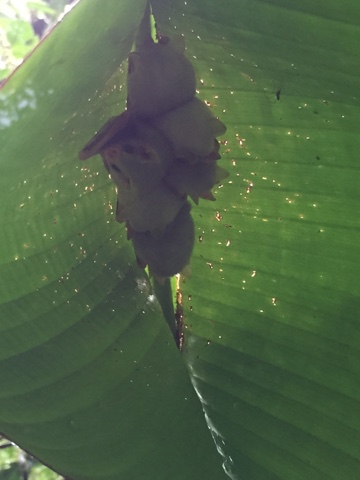August 4th:
Our day started early today with breakfast from 6-7:30 (good practice I guess with the school year quickly approaching!) After breakfast, we met with all of the groups in our classroom on-site, and did a few bonding activities. Had me thinking a lot about my upcoming adventures with Link Crew, the new class I'll be teaching and program I'll be running at CHS this year.
We then exchanged gifts with all of our new colleagues and friends. The Florida group brought us all goodies from NASA (and a Mickey Mouse pencil;)). The Frogger Loggers gave us all little stuffed Einstein finger puppets for our classroom, and the Erie group brought us shells and sea glass from Lake Erie! We brought each of the groups some of Santa Barbara's famous flavored olive oil and it was great to hear about everyone's backgrounds and hometowns.
Right outside our classroom we were greeted (pretty closely) by one of these cute little peccaries!
After gift exchange, Jimmy gave us an introduction to the TEAM Network, and the respective development of ECO Classroom. TEAM, or Tropical Ecology Assessment and Monitoring, began in 2002 in Central and Latin America, and has since spread to 16 sites worldwide. Their research consists of assessing animal and vegetative wildlife in the tropics, and climate changes in the different areas. They have various protocols for setting up camera traps, vegetative quadrats, and systems for measuring temperature, precipitation, humidity etc. every 5 minutes at each site! I am amazed by the extent of their research, availability to the public, and extreme passion possessed by all of their TEAM members.
Shortly after being introduced to TEAM, we met one of La Selva's field biologists, Johanna, who gave us a tutorial on how to collect vegetative data in the tropics. We put on all of our rain gear (as it was pouring, of course, the second we needed to go outside), and went into the jungle. TEAM will typically set up a hectare quadrat (100m x 100m), however we practiced with a 10m x 10m location. We set our coordinates, measured with transect tape the distance of each tree from 0,0, the angle of the tree from the x-axis, and the diameter of the tree about 1.3m from the ground. So much effort and precision goes into measuring each tree and researchers are doing this constantly!! It'd be a really fun activity to do outside with my students :)
Unfortunately during our quadrat building session, Rhonda was bitten by a bullet ant! We were warned, but this is not your typical ant!! (Google it!) she's okay now and feeling better, but has got quite the welt to prove it!
Following lunch, we were given some time to work on our projects. We did some tweaking to our original plan, and mapped out our timeline for the entire trip - I.e. When we'd take samples, when we'd test nitrate levels, when we'd put our presentation together, etc. feeling productive, we made our way back to the classroom to learn about La Selva's vegetative collection!
Orlando runs the herbarium and has lived and worked in La Selva most of his life. He gave us a quick rundown on the natural history of La Selva, followed by their current work with Missouri Botanical Garden and DUKE University (Dad!) on creating a digital flora database for La Selva's collection. They currently have 2,077 species found in La Selva represented by 26,000+ images within the database.
The herbarium itself contains paper records and plant samples of almost every identified species here. The room is kept protected with excessive amounts of air conditioning (which felt great on our tour) and dehumidifiers to protect the paper and samples. It was extremely interesting, yet unsettling to hear how much work there still is to put into this project. Finding money to print labels, ship specimens, store specimens, and upkeep the facility is difficult, and is a large hurdle for La Selva's team to overcome. I felt very fortunate to experience the work they've done first hand!
After the herbarium, Peggy ran through a great quadrat sampling activity that we could run with our students in a biology or environmental science class. I can already tell that I am going to be able to take back so much of this experience and directly apply it to my classroom. (I guess that's the point, right?!) it's just all so applicable, hands-on, interesting, and directly correlative with the new NGSS standards recently adopted by California.
Our scheduled movie night post-dinner was rescheduled due to an interesting GIS talk given by a grad student in the area. (He studies in Canada, at the MER Bleue Conservation Area) After that, we went to the boys' cabin to play Salad Bowl (mix of taboo, charades, etc) and eventually called it a night after a very long, but very exciting day!! Really looking forward to a day hike, canopy tours, and camera traps tomorrow!!
¡Pura vida!
___________________________
Cody's Corner:
Song of the day: "Welcome to the Jungle"
Advice of the day: don't go chasing bullet ants
Nicole's New Species:
Saw a snake on the way to the boys' cabin tonight... Got a picture, super close zoomed in no fear because it was small - turns out it was a fer-de-lance!! The snake responsible for the most fatalities in Costa Rica!!























































